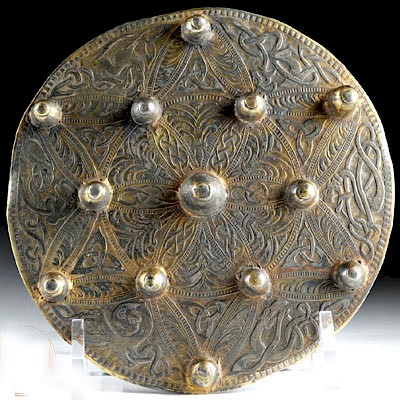3rd C. Gandharan Carved Schist Stupa
Lot 66
About Seller
Artemis Fine Arts
686 S Taylor Ave, Ste 106
Louisville, CO 80027
United States
Selling antiquities, ancient and ethnographic art online since 1993, Artemis Gallery specializes in Classical Antiquities (Egyptian, Greek, Roman, Near Eastern), Asian, Pre-Columbian, African / Tribal / Oceanographic art. Our extensive inventory includes pottery, stone, metal, wood, glass and textil...Read more
Estimate:
$900 - $1,400
Absentee vs Live bid
Two ways to bid:
- Leave a max absentee bid and the platform will bid on your behalf up to your maximum bid during the live auction.
- Bid live during the auction and your bids will be submitted real-time to the auctioneer.
Bid Increments
| Price | Bid Increment |
|---|---|
| $0 | $25 |
| $300 | $50 |
| $1,000 | $100 |
| $2,000 | $250 |
| $5,000 | $500 |
| $10,000 | $1,000 |
| $20,000 | $2,500 |
| $50,000 | $5,000 |
| $100,000 | $10,000 |
| $200,000 | $20,000 |
About Auction
By Artemis Fine Arts
Jul 19, 2018
Set Reminder
2018-07-19 10:00:00
2018-07-19 10:00:00
America/New_York
Bidsquare
Bidsquare : Fine Antiquities/Ethnographic Art
https://www.bidsquare.com/auctions/artemis-gallery/fine-antiquities-ethnographic-art-3329
Featuring classical antiquities, ancient and ethnographic art from cultures encompassing the globe, plus fine art. Artemis Fine Arts info@artemisfinearts.com
Featuring classical antiquities, ancient and ethnographic art from cultures encompassing the globe, plus fine art. Artemis Fine Arts info@artemisfinearts.com
- Lot Description
Northwest Pakistan, Gandhara, ca. 3rd to 4th century CE. A model of a Buddhist stupa, finely carved from grey schist in five sections that are intricately detailed in relief. The square base presents four double columns at the corners, the walls each featuring an open lotus flower surrounded by leafy foliage, with a dentillated frieze above. This pedestal supports, from bottom to top, a drum with floral and geometric motifs, a smaller drum with checkerboard motif, a hemispherical domed structure carved with overlapping leaf forms, capped with a finial resembling a spired pagoda. Size: 7.75" H (19.7 cm)
According to the Metropolitan Museum of Art's Heilbrunn Timeline, "Stupas, the earliest Buddhist monuments preserved in India, began as solid hemispherical domes that marked the remains of a great leader or teacher. They were incorporated into early Buddhist art as symbols of the continuing presence of Shakyamuni Buddha after his parinirvana (final transcendence), and as reminders of the path he defined for his followers. Buddhism carried the stupa throughout Asia, where it was interpreted in many forms, including the domed chortens of Tibet and the spired pagodas of China, Korea, and Japan."
Provenance: private Orange County, California, USA collection; ex-Artemis Gallery; ex-private East Coast, USA collection; ex-private Mussienko, Maryland, USA collection, acquired in the 1980s
All items legal to buy/sell under U.S. Statute covering cultural patrimony Code 2600, CHAPTER 14, and are guaranteed to be as described or your money back.
A Certificate of Authenticity will accompany all winning bids.
We ship worldwide and handle all shipping in-house for your convenience.
#135381Chips to tip and edges of spiral finial tiers. Chips to edges of square base and drums. Expected surface wear commensurate with age. Earthen encrustation in recessed areas.Condition
- Shipping Info
-
All shipping is handled in-house for your convenience. Your invoice from Artemis Gallery will include shipping calculation instructions. If in doubt, please inquire BEFORE bidding for estimated shipping costs for individual items.
-
- Buyer's Premium



 EUR
EUR CAD
CAD AUD
AUD GBP
GBP MXN
MXN HKD
HKD CNY
CNY MYR
MYR SEK
SEK SGD
SGD CHF
CHF THB
THB















